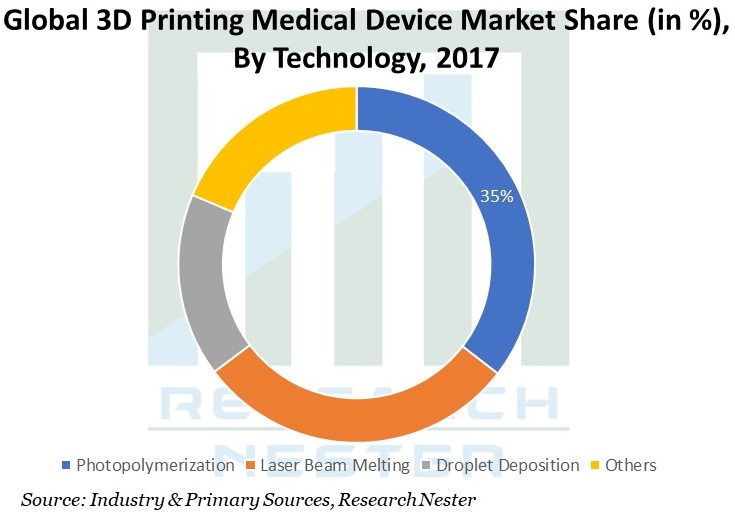3D Printing Medical Device Overview
The growth of the global 3D printing medical device market is thriving on the back of growing advancement in healthcare infrastructure, increasing expenditure of the government for the development of healthcare industry along with the rising demand for organ transplant amongst individuals around the globe. Additionally, advancement in the 3D printing technology and implementation of 3D printing technology in the healthcare sector are some of the factors anticipated to contribute towards the growth of the global 3D printing medical device market.
The global 3D printing medical device market reached a value of around USD 1000 million in the year 2019 and is expected to garner a value of around USD 3200 million by the end of 2026 by registering a CAGR of around 17% across the globe over the forecast period 2019-2026. Further, the worldwide market of 3D printing medical device is anticipated to achieve an absolute $ opportunity of around USD 2200 million during the forecast period.
Growth Highlights based on Region during 2017-2026
The global 3D printing medical device market is segmented by regions into North America, Latin America, Europe, Asia-Pacific and Middle East and Africa. Among these regions, the market of North America 3D printing medical device is primarily driven by nations such as U.S. and Canada, where U.S. held the dominant market share of around 64% in the year 2017. The growing initiatives observed in the educational institutes along with education grants and R&D funding in leading research institutes in the nation, which are increasingly procuring 3D technology devices along with growing interest of the government of the nation to invest on such devices for advancements and in-depth research and development are driving the growth of the market in the nation. Additionally, the North America 3D printing medical device market, which held a market share of around 35% in the year 2017, is expected to expand by observing the growth rate of around 3.40x over the forecast period, which in turn is estimated to have a positive effect on the demand for 3D printing medical devices in the long run.
Further, Germany, France and UK are the prominent countries that are driving the growth of the Europe 3D printing medical device market, where Germany accounted for the largest market share of around 27% in the year 2017.

The study further incorporates Y-O-Y Growth, demand & supply and forecast future opportunity in North America (United States, Canada), Latin America (Brazil, Mexico, Argentina, Rest of LATAM), Europe (U.K., Germany, France, Italy, Spain, Hungary, BENELUX [Belgium, Netherlands, Luxembourg], NORDIC [Norway, Denmark, Sweden, Finland], Poland, Russia, Rest of Europe), Asia-Pacific (China, India, Japan, South Korea, Malaysia, Indonesia, Taiwan, Hong Kong, Australia, New Zealand, Rest of Asia-Pacific), Middle East and Africa (Israel, GCC [Saudi Arabia, UAE, Bahrain, Kuwait, Qatar, Oman], North Africa, South Africa, Rest of Middle East and Africa).
Market Segmentation Synopsis
By Technology
The global 3D printing medical device market has been segmented on the basis of technology into photopolymerization, laser beam melting, droplet deposition and others. Photopolymerization segment with around 35% share in the year 2017, occupies the largest market share of 3D printing medical device across the globe. Additionally, photopolymerization segment is anticipated to cross a value of around USD 1200 million by the end of 2026 by registering a CAGR of around 18% over the forecast period. Further, the droplet deposition segment is anticipated to grow with a CAGR of around 17% over the forecast period.

Market Drivers and Challenges
Growth Indicators
The healthcare sector has always generated a major share of the total turnover of 3D printing technology owing to the increasing applications in the healthcare industry. 3D printing technology is massively used in dental, orthopedic and acoustic fields in the healthcare industry for innovative areas such as 3D printing of tissues, organs and bones amongst others, where the application of these devices has seen significant growth. 3D printing technology helps to print surgical instruments such as hemostats, forceps, scalpel handles and others. These technology and devices are also used by manufacturers to develop product prototypes, which helps specialists in the industry to perform their day-to-day task as well as develop advanced tools in the healthcare industry. Apparently, increasing geriatric population around the world, which demands a greater share of organ implants, is also anticipated to drive the growth of the global 3D printing medical device market.
Barriers
Stringent regulation of the governments of nations around the world for the utilization of 3D printing technology as access to these devices can severely possess a threat to the healthcare industry are some of the factors anticipated to impact negatively towards the growth of the global 3D printing medical device market.
Top Featured Competitive Landscape
Some of the affluent industry leaders in the global 3D printing medical device market are Prodways Group, Formlabs, Stratasys Ltd., 3D Systems, Inc., Materialise NV, Organovo Holdings, Inc., Renishaw plc, Envisiontec, Inc., EOS GmbH and General Electric.

